In this 7 1/2 minute video Hans Rosling maps the relationship between life expectancy, GDP, and sexual health and rights over 300 years of Swedish history:
Found at GapMinder.
In this 7 1/2 minute video Hans Rosling maps the relationship between life expectancy, GDP, and sexual health and rights over 300 years of Swedish history:
Found at GapMinder.
USA Today posted an interactive graphic demonstrating how different types of college athletes cluster into majors differently at different schools (via Montclair Socioblog). For example, the screenshot below includes the data for all athletes in the study. Each rectangle represents a school; the darker the blue, the more concentrated major choices are for that team at that school. In this iteration, the darkest blue rectangle in the “social science” category represents Louisiana Tech at which 80 percent of male basketball players major in Sociology:
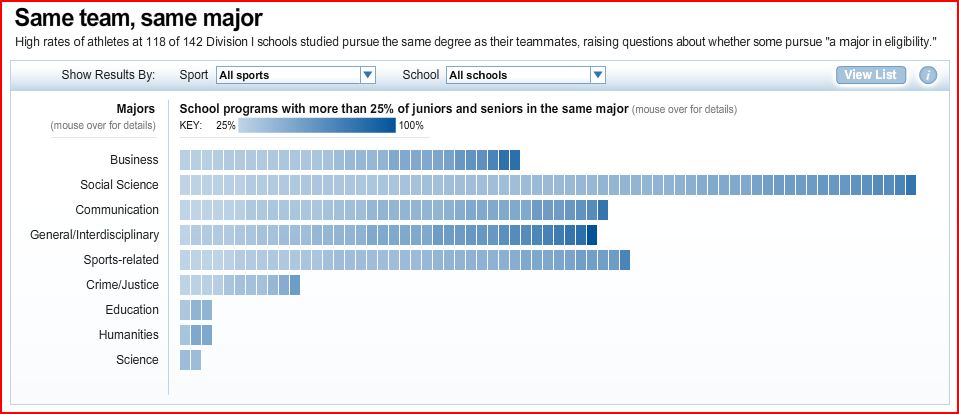
This screenshot features football players only. At Georgia Tech, 82 percent of football players major in Business:
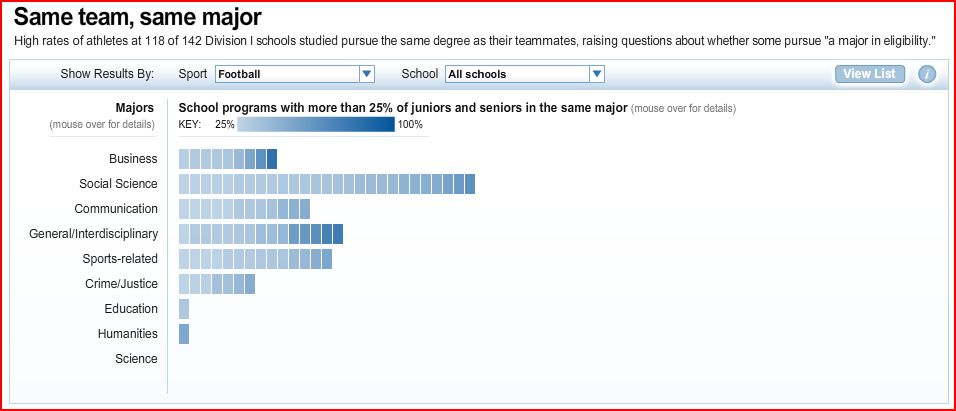
If you visit the site, you can manipulate the graphic as you like and see what school and team each rectangle represents.
Certain majors have long been rumored to be athlete friendly and I think this actual data sheds a lot of light on the false stereotype of both disciplines and athletes.
The article doesn’t speculate as to why teammates cluster, but we could…
I was recently speaking to a colleague at my College who remembered a time during which a good percentage of the football players majored in Sociology. He suggested that this was because one of the most high-profile football players, one who was very well-liked by his teammates and had a leadership role on the team, majored in Sociology. Since that player has left the College, the percent of football players in our major has decreased. In that sense, part of the explanation for why teammates cluster may be more social psychological than sociological.
What are your theories?
Mercedes DeM. sent in this Vanity Fair cover (for April 2009)…
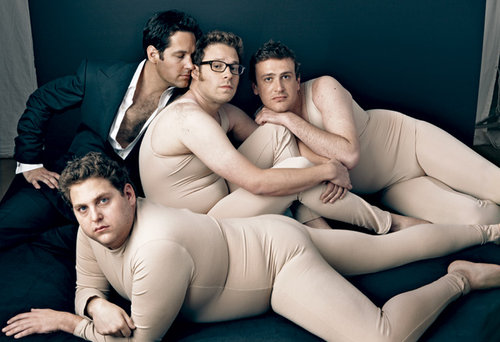
…spoofing this previous cover:

The women on the original cover are sex symbols. We should expect gratuitous nudity. The men in the spoof, in contrast, are comedians and so a direct comparison, arguing that men’s bodies are more off-limits, would be misguided. (Not that I think an argument couldn’t be made, but I don’t think this set of images supports it.)
Nor do I think that these images support the idea that we’re more accepting of variation in men’s bodies than women’s. If that were so, I think the men would actually be nude. Instead they’re covered up. My sense is that they’re covered up because their bodies are, according to rigid cultural standards, gross.
The relevant comparison, I think, would be between the spoof cover and a similar spoof cover featuring non-skinny women in nude body suits. The fact that the former is funny points to how men are allowed to be many things. They can be good-looking and fit, OR they can be not-so-good-looking, but rich, nice, or funny. And we still like them. There is no disdain for these men. We may even like them MORE because they’re willing to pose in ways that reveal how imperfect their bodies are.
I think we would be unlikely to see a similar cover featuring women, even women comedians, because women are allowed to be rich, nice, or funny but they must ALSO be good-looking and fit. A cover featuring chubby women would JUST be gross. It wouldn’t be gross and funny.
Being good-looking and fit is ONE way for men to be admire in our society. Being good-looking and fit is a REQUIREMENT for women to be admired, no matter what else she brings to the table.
I asked myself: in the entire history of Vanity Fair, would we be able to find three women with a similar body type to those men on the cover?
I found two, both featuring Roseanne Barr (images here and here):

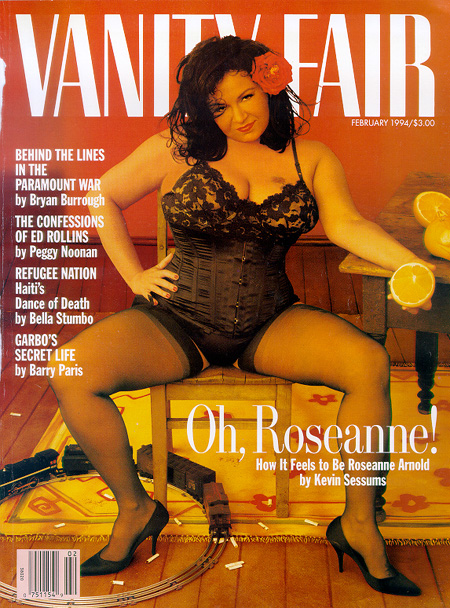
The covers feature a comedian who is well-known for being successful while bucking social expectations for women. She’s the exception to the rule that proves the rule. Or is she? I certainly think so. That “Oh, Roseanne!” is about how crazy she is.
In any case, notice that she’s still a sex symbol, while the men in the spoof are decidedly not. They’re spoofing such symbolism. Roseanne, despite her wacky resistance, still has to abide by it.
The Scion is an interesting study in marketing. Scion (noun: descendant) is a subsidiary of Toyota. Why Scion? Well, Toyota wanted to sell cars to young, hip, urban guys but (as we all know) Toyotas are for fuddy duddies (yeah I’m talkin’ to you). So Toyota started Scion. Scions are really just Toyotas, less the fuddy duddy baggage. Toyota has marketed Scions accordingly. Here are some commercials:
Scion advertising features young people of color, usually men, in urban spaces (found here):
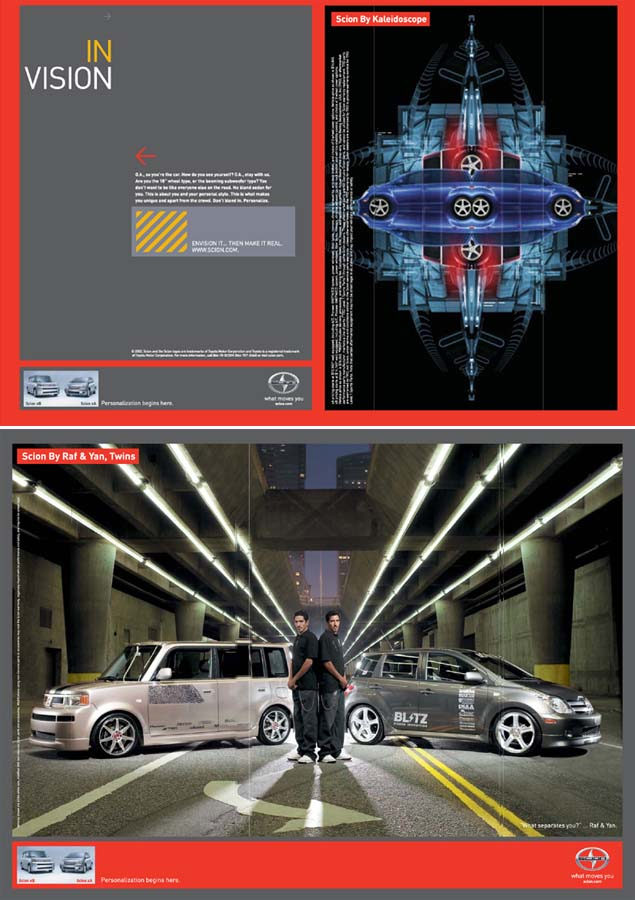
I have a Scion. This one:

When I walked into the Madison, Wisconsin Toyota dealer to purchase it, there were a dozen middle-aged white men with pot-bellies, and a Latina that looked about 16 years old. She was the Scion salesperson. (Hi Celia!)
Also appealing to its intended customers, Toyota encourages you to customize your Scion. When I purchased the car, I had the option of adding neon trim around the bottom of the car, glowing cup holders, and giant speakers that took up the entire back seat. Factory installed. (I opted for all three, of course.)
Scion encourages these additions. As the commercials show, Scion emphasizes customization and the individualization of your car. “United by Individuality” is one of their advertising themes (found here):

Underneath each of these unique Scions is the name of its owner. These names include Carlos V., Claudell D., Javier C., Benilda D., Jesus V., Kekai K., Nickoli C., Mario N., Einar A., Jose S., and Jose R. They’re definitely not marketing to the stereotypical Toyota crowd.
The marketing of the Scion points to how we separate old from young and then layer the binary with further binaries: boring/exciting, suburban/urban, conformity/individuality, and even white/non-white. Toyota doesn’t sell Scions by constantly reminding us that Scions are Toyotas (with all the dependability and efficiency that Toyotas are known for), just the opposite. And youth, Toyota appears to believe, want to differentiate themselves from dull, grown-up, suburban, whitebread conformity as much as possible.
But here’s the twist:
Celia (who I bought my Scion from in Madison, Wisconsin) told me that, despite all of their efforts, the “boxy” Scion (the one on the left in the first print ad) is bought disproportionately by elderly people. Why? Because the spacious interior holds a wheelchair just as easily as a mountain bike or a drum kit and the height of the car makes it easy to get in and out of without having to pull yourself up or lower yourself down.
Marketing, thanks to human creativity and free will, has its limits and marketers can’t always predict how their strategies will play.
Hyperion submitted a great illustration of cultural change. Today, cigarette smoking is illegal in most public places, but there was a time in which cigarette smoking was normative instead of deviant. This radar analysis instrument, in use through the 1950s through 1980s, includes a built-in cigarette lighter and ashtray:

More on this and like instruments here.
Thanks Hyperion!
Laura W. sent us a link to a review of sex education in the U.K. that featured a three minute video. The video is a clip from a 1917 film, called “Whatsoever a Man Soweth,” encouraging Canadian soldiers to refrain from having sex with prostitutes. It was important for states to keep their soldiers from hiring prostitutes because soldiers filled up the sick bay with sexually transmitted infections that, during World War I, were not easily cured with antibiotics. Watch it here.
Also in soldiers and STIs: “Bad” women as disease vectors.
Britt Karp, Occidental College student and all-around great person, saw this public service notice on a subway in Manhattan:

Britt remarks:
Why is the message not – don’t sexually assault people?! Instead of reprimanding perpetrators of sexual assault (most frequently men), this poster places the responsibility on the person who is being assaulted (usually a woman). By doing this, it completely normalizes sexual harassment. The poster alludes to the argument touted by evolutionary psychologists – that it is in men’s nature to sexually assault women and so trying to control this behavior is futile. In this way, they make it seem that the only way to deal with this issue is for women to be braver. It’s no wonder women so frequently blame themselves when they are sexually assaulted.
NEW! Rachel McC. J., from Deeply Problematic, sent us another example of a poster asking women to stop men from behaving badly. This one targets young girls, telling them to turn away older men:
